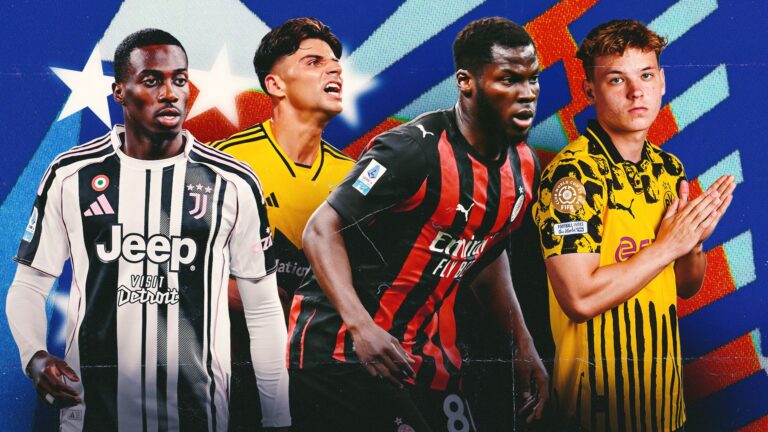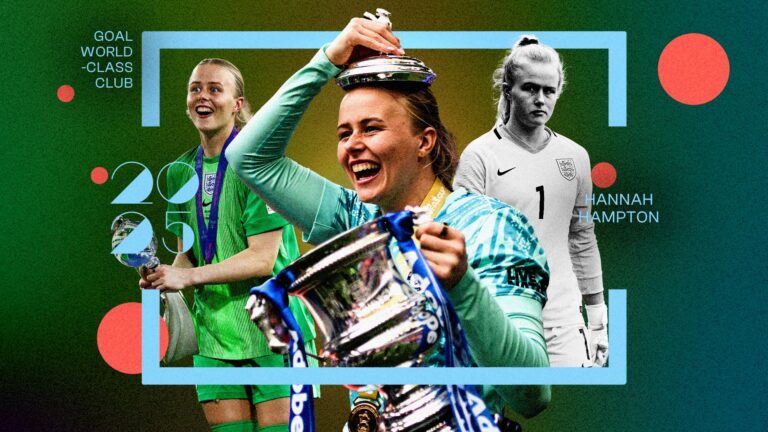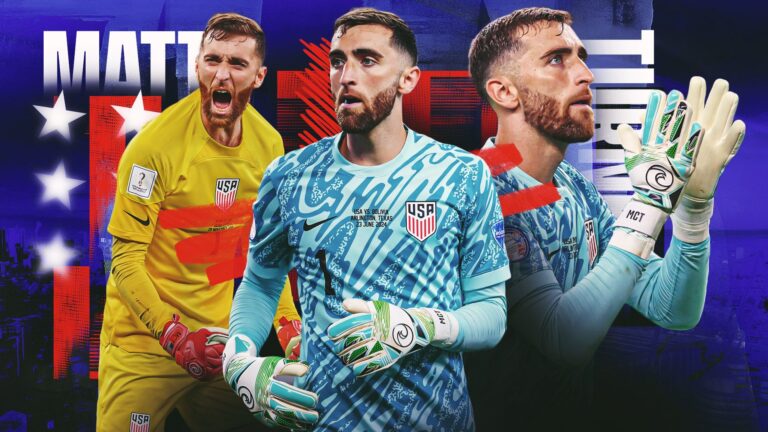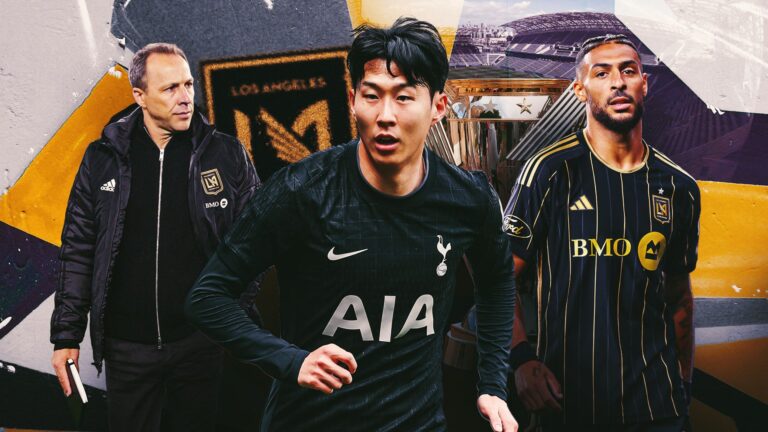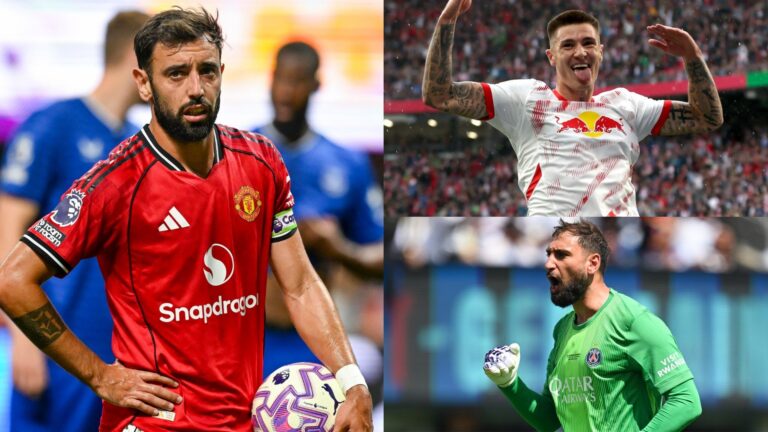Charlotte FC didn’t want the money. They wanted to keep their guy. The money is nice, of course, especially considering how unexpected it would be to collect a hefty transfer fee. But money alone doesn’t win you games. Players do. Players such as Patrick Agyemang.
Last week, Charlotte were handed a pile of cash from English side Derby County in exchange for Agyemang’s services – $8 million, in fact, with perhaps more coming. It’s a club-record fee and, in truth, a substantial infusion of cash, especially considering Charlotte unearthed Agyemang from the MLS SuperDraft after his college stints at Eastern Connecticut and Rhode Island.
It can hardly be classified as anything other than good business. The club took a player that no one else really wanted, developed him into a U.S. men’s national team regular and, inevitably, sold him for a hefty fee that they can reinvest in their team. In many ways, it’s the dream scenario for a club – and for Agyemang, whose journey from the lowest levels of college soccer in New إنجلترا to a club role in England is inspiring.
The problem, of course, is timing. Charlotte didn’t want to lose Agyemang in the middle of their MLS season. Derby County, surely, didn’t want to wait for him. Charlotte tried to convince him to stay with a new contract, one that had been in the works for months. Ultimately, though, the time was right for Agyemang, even if it wasn’t for the club that had to watch him go.
This epitomized the challenge for MLS teams. These types of transfers can derail a season. But can it be fixed? Is there a way for clubs such as Charlotte to entice a player such as Agyemang to stay?
At the moment, the answer would seem to be no. Given the salary cap structure, it’ll always be difficult for clubs to reward surprise players such as Agyemang with the contracts they deserve. Clubs can’t put money aside to bank on former D3 college players to become stars. So when the time comes to find that money, it’s never easy.
Where does that leave MLS clubs? The reality is that holding on to genuine talent is becoming harder.
"It’s a challenge to keep top talents all over the world," Charlotte FC general manager Zoran Krneta said. "This isn’t only Charlotte. It’s not only MLS. All of the leagues are selling to bigger, wealthier leagues in Europe. That’s the process. But he’s done great for us. We are grateful to him. We wish him all the best going forward. But it was time for him to go because he wanted to go. He expressed that desire to us on several occasions."
Agyemang won’t be the first or the last. But changes may be coming that could make these dilemmas less common for MLS clubs.






Charlotte FC didn’t want the money. They wanted to keep their guy. The money is nice, of course, especially considering how unexpected it would be to collect a hefty transfer fee. But money alone doesn’t win you games. Players do. Players such as Patrick Agyemang.
Last week, Charlotte were handed a pile of cash from English side Derby County in exchange for Agyemang’s services – $8 million, in fact, with perhaps more coming. It’s a club-record fee and, in truth, a substantial infusion of cash, especially considering Charlotte unearthed Agyemang from the MLS SuperDraft after his college stints at Eastern Connecticut and Rhode Island.
It can hardly be classified as anything other than good business. The club took a player that no one else really wanted, developed him into a U.S. men’s national team regular and, inevitably, sold him for a hefty fee that they can reinvest in their team. In many ways, it’s the dream scenario for a club – and for Agyemang, whose journey from the lowest levels of college soccer in New England to a club role in England is inspiring.
The problem, of course, is timing. Charlotte didn’t want to lose Agyemang in the middle of their MLS season. Derby County, surely, didn’t want to wait for him. Charlotte tried to convince him to stay with a new contract, one that had been in the works for months. Ultimately, though, the time was right for Agyemang, even if it wasn’t for the club that had to watch him go.
This epitomized the challenge for MLS teams. These types of transfers can derail a season. But can it be fixed? Is there a way for clubs such as Charlotte to entice a player such as Agyemang to stay?
At the moment, the answer would seem to be no. Given the salary cap structure, it’ll always be difficult for clubs to reward surprise players such as Agyemang with the contracts they deserve. Clubs can’t put money aside to bank on former D3 college players to become stars. So when the time comes to find that money, it’s never easy.
Where does that leave MLS clubs? The reality is that holding on to genuine talent is becoming harder.
“It’s a challenge to keep top talents all over the world,” Charlotte FC general manager Zoran Krneta said. “This isn’t only Charlotte. It’s not only MLS. All of the leagues are selling to bigger, wealthier leagues in Europe. That’s the process. But he’s done great for us. We are grateful to him. We wish him all the best going forward. But it was time for him to go because he wanted to go. He expressed that desire to us on several occasions.”
Agyemang won’t be the first or the last. But changes may be coming that could make these dilemmas less common for MLS clubs.
Dean Smith knows the بطولة. Before he took over coaching duties at Charlotte FC, he led Villa out of that division and into the Premier League. He spent time in England’s second division with برينتفورد and Norwich City, too. Smith is an authority on the matter, and that’s why he urged Agyemang to stay.
“The fact that we haven’t been able to agree a new contract with Patrick and his representatives has always indicated that this was likely to happen, whether it was in this window or at the end of the season,” Smith said ahead of Agyemang’s move. “I do feel that this is probably been pushed by his representatives more than the actual player. I’ll be surprised if he goes to the Championship in the U.K. The Championship is not too different from MLS. This is a major league over here. You’re going to a second league in the U.K.
“I’ve had the conversation with Patrick and my answer was that I don’t think he should go. I want him to stay, but it’s up to the player to make that decision. … I did remind Patrick, ‘Remember, agents work for you, not the other way around.’ “
That’s Smith’s perspective and is, in many ways, easy to understand. The Championship isn’t glitzy or glamorous. It’s a grind. This wasn’t a player joining ريال مدريد or Barcelona. He was joining a Derby County team that, just a few short years ago, looked as if it could go out of business.
Agyemang’s side is just as easy to understand. In a كأس العالم year, Agyemang has a chance to be a member of the USMNT. Scoring boatloads of goals in the Championship might help him do that. It’s a risk, of course, as now he’ll be compared directly to fellow USMNT striker candidates Josh Sargent, Damion Downs and Haji Wright.
But Agyemang is betting on himself while achieving a dream of playing in Europe.
Of course, though, there’s a financial aspect to this, which is where it becomes important to understand the innner-workings of MLS.
Per the MLS Players Association’s annual report, Agyemang was making $104,000 this year with Charlotte FC. That’s up from the $71,000 he made last season. Per Capology, the average Championship salary is more than $800,000. Agyemang will likely make more given the significant fee Derby paid to acquire his services.
There have been times in MLS history in which teams have been able to solve such situations. The Seattle Sounders, for on- and off-field reasons, were able to keep Jordan Morris. Miles Robinson was paid handsomely to turn down European offers to stay within MLS with نادي سينسيناتي لكرة القدم. Landon Donovan, famously, spent the bulk of his career in MLS when he could have played just about anywhere in the world.
In those instances, clubs made it work, financially and otherwise. But that isn’t always possible.
Charlotte FC, ultimately, weren’t able to find a way to make the numbers work. There were multiple contract offers, and everyone involved knew that this day was likely to come. Eventually, the club had to accept that.
“We tried to keep him and offer him a contract,” Krneta said. “We offered him multiple contracts, every time better and better. But it was time for him to move and it got to a point where we had to make the best possible deal for the club.”
That deal does benefit Charlotte’s finances. But it also brings something nearly as important: validation. أتلانتا يونايتد used it to go from Miguel Almiron to Thiago Almada, making millions along the way. Now, their southeastern rivals can point to young players and ask them if they want to be the next Agyemang, the next big sale to a league in Europe that, ultimately, is a preferred destination.
That’s not always how the league approached things. Commissioner Don Garber famously said he wanted MLS to be a “League of choice.” But over the years, the choice has changed. The league, as a whole, has pivoted into its place in the market, becoming what MLS needs to be right now: a selling league.
“It’s not frustrating at all,” Garber said. “We’re operating in a global market, and that global market is all about developing players and having those players either stay and continue here or go on and play in another league. In his case, it was a great career move.
“He went to a small college and then went to Rhode Island and came here in the draft. And now he’s sold for nearly $10 million. He played in MLS Next Pro, our development league, and we’re trying to prove that the vertical pyramid is a great way to develop players.”
Garber, essentially, called it a win-win.
“I think that it’s a real positive for Charlotte,” he said. “Now, Charlotte has to ensure that who they have coming in will be able to match his goals and be as much of a fan favorite. And if that player should leave, then someone else comes around. As I like to say, ‘That’s football.’ “
Charlotte FC aren’t the only player to lose a star this window. In fact, نادي سان دييغو لكرة القدم might have been hit even harder.
He may not be the Golden Boot leader but, during his time in San Diego, Milan Iloski established himself as the league’s most lethal finisher. In just 471 minutes, Iloski scored 10 goals for the MLS expansion side, becoming a key part of a rise that has seen them defy all expectations this year.
And now he’s gone.
Iloski was initially signed on a short-term loan from Nordsjælland. San Diego ultimately terminated the loan early to allow him to return to الدنمارك after all parties failed to come to an agreement to extend the arrangement. According to GiveMeSport, both sides wanted to make a permanent deal work.
The issue? Money. The two sides were too far apart and, while they could reportedly reconnect down the line, Iloski ultimately opted to explore other options.
After failing to make it with Real Salt Lake, Iloski dropped down to the lower divisions to score 43 goals over two seasons with Orange County SC. That earned him a move to Nordsjaelland and, eventually, a second crack at MLS, -one that he ran with by scoring goal after goal. His success could not have been anticipated, which is why everyone was so far apart, given his $156,000 salary this season.
“He came here on loan, on a short-term loan, we worked diligently to make it long-term,” head coach Mikey Varas said. “We couldn’t come to an agreement. We wanted to respect Milan’s wishes to go test himself in Europe. We wish him nothing but the best and are just focused on the guys we have now.”
Sound familiar? Iloski, like Agyemang, was a surprise success story. This was a guy who arrived on the cheap and blossomed into a star. The salary cap structure makes it hard to keep those guys, particularly when there are plenty of leagues overseas unencumbered by such rules.
MLS clubs can set aside budget for Designated Players and high-potential players; keeping those that outperform their potential, then, becomes harder, due to the outlay on the former.
Ultimately, though, this isn’t just an MLS problem. This is reality in American sports. The only difference here is that the marketplace is global, making the process of retaining unexpected stars even harder.
There’s a roster-building theory in the اتحاد كرة القدم الأميركي in which general managers look to maximize a certain window. That window is a quarterback’s rookie deal. During those first few years in the league, the quarterback, the team’s most important player, is barely denting the salary cap, making it possible to spread money to build a more stable roster. If that rookie QB can then outperform his contract, you have a Super Bowl contender.
And then the team can pay him what he’s worth.
Agyemang and Iloski, in this comparison, were on their rookie QB deals. Because of that, Charlotte FC, for example, could spread spending throughout the squad. The Designated Player spots went to Wilfried Zaha and Liel Abada, talented wingers.
They were able to afford playmaker Pep Biel. Veterans such as Tim Ream and Ashley Westwood were affordable, too, largely because Charlotte FC didn’t have to allocate big resources to the striker position.
It’s a principle that applies across sports. The Oklahoma City Thunder built the NBA’s deepest roster around Shai Gilgeous-Alexander because key pieces Chet Holmgren and Jalen Williams were on cheaper contracts. With an NBA championship in hand, those two got their paydays – and the team will have decisions to make regarding their salary cap situation going forward.
The New York Knicks, meanwhile, have risen to be one of the Eastern Conference’s best teams because their star, Jalen Brunson, took less money to fill out the roster, allowing the team to maximize spending in other spots.
All of this is to say that navigating salary caps is challenging, and it isn’t exclusive to one sport. MLS is certainly complicated, given all of the various mechanisms. And it has to account for teams outside of Europe’s top five leagues, who have enough money attact players with the allure of fulfilling dreams.
That won’t change any time soon. But other changes could be coming.
MLS officials regularly review and discuss changes to the structure. Reports indicate that a schedule switch may be on the horizon, while there has long been speculation that the league will be adding more money and more ways to acquire, and keep, talent.
“There will potentially be some changes,” Krneta said. “I’m excited about those changes because I think the league will grow, but certain changes need to be made so we can potentially invest money and potentially keep the players like Patrick Agyemang here, give them bigger contracts with less salary restrictions.”
MLS will certainly be looking at ways to improve the quality of the league, particularly after the Club World Cup. Part of improving the quality, though, is about keeping the best players in-house. It will always be hard to do that given the allure of Europe, but money – and flexibility in how to spend it – can go a long way to counter that allure.
Until then, players such as Aygemang and Iloski will have to make tough decisions. So, too, will clubs. As Garber says, that’s football.





